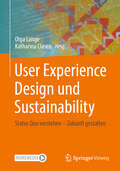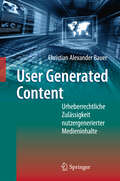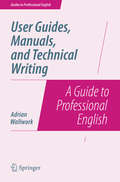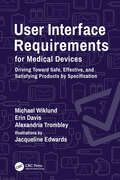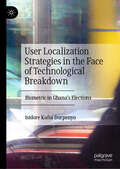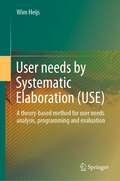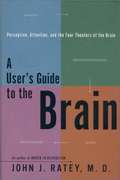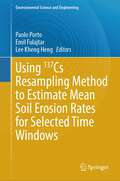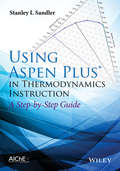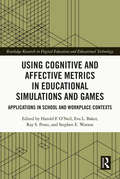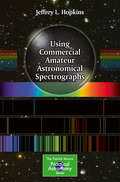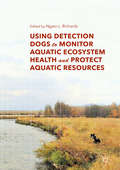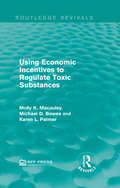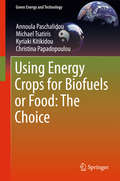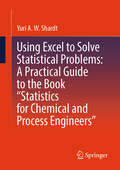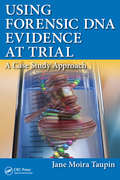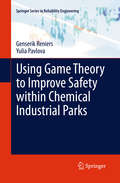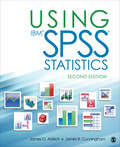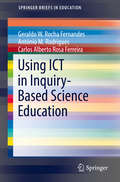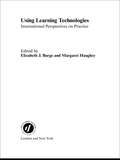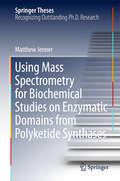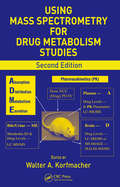- Table View
- List View
Useless Arithmetic: Why Environmental Scientists Can't Predict the Future
by Orrin H. Pilkey Linda Pilkey-JarvisNoted coastal geologist Orrin Pilkey and environmental scientist Linda Pilkey-Jarvis show that the quantitative mathematical models policy makers and government administrators use to form environmental policies are seriously flawed. Based on unrealistic and sometimes false assumptions, these models often yield answers that support unwise policies. Writing for the general, nonmathematician reader and using examples from throughout the environmental sciences, Pilkey and Pilkey-Jarvis show how unquestioned faith in mathematical models can blind us to the hard data and sound judgment of experienced scientific fieldwork. They begin with a riveting account of the extinction of the North Atlantic cod on the Grand Banks of Canada. Next they engage in a general discussion of the limitations of many models across a broad array of crucial environmental subjects. The book offers fascinating case studies depicting how the seductiveness of quantitative models has led to unmanageable nuclear waste disposal practices, poisoned mining sites, unjustifiable faith in predicted sea level rise rates, bad predictions of future shoreline erosion rates, overoptimistic cost estimates of artificial beaches, and a host of other thorny problems. The authors demonstrate how many modelers have been reckless, employing fudge factors to assure "correct" answers and caring little if their models actually worked.A timely and urgent book written in an engaging style, Useless Arithmetic evaluates the assumptions behind models, the nature of the field data, and the dialogue between modelers and their "customers."
User Experience Design und Sustainability: Status Quo verstehen – Zukunft gestalten
by Olga Lange Katharina ClasenDieses Buch ist ein Handbuch für alle Gestalter*innen, die mit User Experience (UX) Design mehr zur nachhaltigen Entwicklung von Systemen, Produkten und Dienstleistungen beitragen möchten. Arbeitskreis "Design for Sustainability" der German UPA wurde im Jahr 2023 gegründet und widmet sich allen aktuellen Themen aus dem Bereich UX für Nachhaltigkeit. Als Grundlage für dieses Werk diente eine umfassende Umfrage der UX-Gestalter: innen zum Thema "Design for Sustainability". Somit wurde ein Status Quo erfasst, um die zukunftsweisenden Beiträge und Handlungsempfehlungen für die Zukunft auszuarbeiten. Viel Spaß beim Lesen und Umsetzen!
User Generated Content
by Christian Alexander BauerDas Web 2.0 hat zu einem Wandel des Nutzerverhaltens in Internet geführt: Immer mehr Nutzer gehen vom passiven Konsum über zu einem interaktiven Nutzungsverhalten. Bei einem Großteil der produzierten Beiträge greifen sie dabei auf fremde, zumeist urheberrechtlich geschützte Inhalte zurück. Vor diesem Hintergrund geht der Autor der Frage nach, inwieweit diese unautorisierte Verwendung fremder Werke und Leistungen urheberrechtlich zulässig ist und in welchem Umfang dieses Phänomen zukünftig vom Gesetzgeber privilegiert werden sollte.
User Guides, Manuals, and Technical Writing: A Guide to Professional English (Guides to Professional English)
by Adrian WallworkThis book is intended for anyone whose job involves writing formal documentation. It is aimed at non-native speakers of English, but should also be of use for native speakers who have no training in technical writing.Technical writing is a skill that you can learn and this book outlines some simple ideas for writing clear documentation that will reflect well on your company, its image and its brand.The book has four parts:Structure and Content: Through examples, you will learn best practices in writing the various sections of a manual and what content to include.Clear Unambiguous English: You will learn how to write short clear sentences and paragraphs whose meaning will be immediately clear to the reader.Layout and Order Information: Here you will find guidelines on style issues, e.g., headings, bullets, punctuation and capitalization.Typical Grammar and Vocabulary Mistakes: This section is divided alphabetically and covers grammatical and vocabulary issues that are typical of user manuals.
User Interface Requirements for Medical Devices: Driving Toward Safe, Effective, and Satisfying Products by Specification
by Erin Davis Michael Wiklund Alexandria TrombleyThis book is a practical guide for individuals responsible for creating products that are safe, effective, usable, and satisfying in the hands of the intended users. The contents are intended to reduce the number of use errors involving medical devices that have led to injuries and deaths. The book presents the strong connection between user interface requirements and risk management for medical devices and instructs readers how to develop specific requirements that are sufficiently comprehensive and detailed to produce good results – a user-friendly product that is likely to be used correctly. The book’s tutorial content is complemented by many real-world examples of user interface requirements, including ones pertaining to an inhaler, automated external defibrillator, medical robot, and mobile app that a patient might use to manage her diabetes. The book is intended for people representing a variety of product development disciplines who have responsibility for producing safe, effective, usable, and satisfying medical devices, including those who are studying or working in human factors engineering, psychology, mechanical engineering, biomedical engineering, systems engineering, software programming, technical writing, industrial design, graphic design, and regulatory affairs.
User Localization Strategies in the Face of Technological Breakdown: Biometric in Ghana’s Elections
by Isidore Kafui DorpenyoThis book examines Ghana’s use of the fingerprint biometric technology in order to further conversations about localization championed by technical communication scholars. Localization, in this case, refers to the extent to which users demonstrate their knowledge of use by subverting and reconfiguring the purpose of technology to solve local problems. Dorpenyo argues that the success of a technology depends on how it meets the users’ needs and the creative efforts users put into use situations. In User Localization Strategies in the Face of Technological Breakdown, Dorpenyo advocates studying how users of technological systems construct knowledge about the technology and develop local strategies to solve technological breakdowns. By analyzing technical documents and interview transcripts, the author identifies and advances three user localization strategies: linguistic localization, subversive localization, and user-heuristic experience localization, and considers how biometric systems can become a tool of marginalization.
User needs by Systematic Elaboration (USE): A theory-based method for user needs analysis, programming and evaluation
by Wim HeijsThe design of a building can facilitate the process of use and promote the well-being of users if it meets their needs. Knowledge of user needs and processes of use is important for a good design. However, it is not self-evident what user needs really are, how user needs and processes of use can be researched, and how that knowledge can be used in a design. This book introduces an integrated methodology for the analysis of user needs, programming and evaluation that answers these questions. The purpose is to improve the interaction between the users and their environment and to avoid failure costs by facilitating proper design decisions. The theoretical perspective and the conceptual framework originate from environmental psychology, more specifically P-E fit theory. The target group consists of those who are interested in creating environments for people (designers, users, real estate managers; students and scientific staff). Designers are a special audience for whom the book can be a guide to working for and with users. The theoretical perspective and the conceptual framework can also be relevant for scientific research into the interaction between users and buildings.
User's Guide to the Brain: Perception, Attention, and the Four Theaters of the Brain
by John J. RateyFor the first time ever, discoveries in our understanding of the brain are changing anthropology, linguistics, philosophy, and psychology--indeed, the brain itself may become a catalyst for transforming the very nature of these inquiries. In A User's Guide to the Brain, Dr. John Ratey, best-selling coauthor of Driven to Distraction, explains in lucid detail and with perfect clarity the basic structure and chemistry of the brain: how its systems shape our perceptions, emotions, actions, and reactions; how possession of this knowledge can enable us to more fully understand and improve our lives; and how the brain responds to the guidance of its user. He draws on examples from his own practice, from research, and from everyday life to illuminate aspects of the brain's functioning, among them prenatal and early childhood development; the perceptual systems; the processes of consciousness, memory, emotion, and language; and the social brain. As the best means for explaining the dynamic interactions of the brain, Ratey offers as a metaphor the four "theaters" of exploration: 1) the act of perception; 2) the filters of attention, consciousness, and cognition; 3) the array of options employed by the brain--memory, emotion, language, movement-to transform information into function; and 4) behavior and identity. Ratey succeeds not only in giving us a compelling portrait of the brain's infinite flexibility and unpredictability but also in demonstrating how our very understanding of the brain affects who we are.
Using 137Cs Resampling Method to Estimate Mean Soil Erosion Rates for Selected Time Windows (Environmental Science and Engineering)
by Paolo Porto Emil Fulajtar Lee Kheng HengThis book provides guidelines for using a new approach of resampling the Cs-137 radionuclide tracer which is used to estimate soil erosion rates. The Cs-137 resampling approach will improve significantly the use of the Cs-137 method for assessment of soil erosion, because resampling the radionuclide repeatedly (at least two times, but more sampling campaigns are possible) allows to avoid several methodological difficulties associated with Cs-137 method, namely the problems with small-scale spatial heterogeneity, the question of representativeness of reference site, reference samples, and inappropriate time extent of evaluated period. All these methodological problems are very important for reliability and accuracy of erosion rates estimated by Cs-137 method. If using single sampling approach, the small-scale spatial heterogeneity can be overcome by high number of sampling points, but this is time and labour demanding solution increasing the expenses of the erosion research. The representativeness of reference site is evaluated usually on the basis of expert judgement and knowledge of land use history of studied area, but this approach is often uncertain because the expert judgement can be subjective and the data on land use history is often not sufficient. Further, in many areas an appropriate reference site is not available, what limits the territorial extent of using Cs-137 method. The resampling approach offers its second sampling to be done in a proximate vicinity of the same points sampled during the first sampling campaign. A great advantage is the possibility to decide how long time windows should be investigated. Choosing the time schedule of first and second sampling allows to shorten the time window and adjust it to the study objectives. This is a great improvement of the Cs-137 method, because the time period since the Cs-137 fallout is still growing and thus if using the single sampling approach the results refer to still longer and longer time window(since the Cs-137 fallout until the sampling time), and this period (recently ca 60 years assuming the maximum Cs-137 fallout in 1963) is too long to represent stable land use, because land uses are changing over the time and having the same land use over six decades is rather rare. The improvement of Cs-137 method achieved by resampling approach is significantly contributing to understanding the erosion dynamics and estimating its rates under changing environmental conditions (such as land uses, weather), and it will bring a significant benefit to soil conservation programmes, because Cs-137 method is indispensable for assessing the medium and long term soil erosion rates, and this information is among the basic inputs needed for planning and designing soil conservation measures.
Using Aspen Plus in Thermodynamics Instruction
by Stanley I. SandlerA step-by-step guide for students (and faculty) on the use of Aspen in teaching thermodynamics * Easily-accessible modern computational techniques opening up new vistas in teaching thermodynamicsA range of applications of Aspen Plus in the prediction and calculation of thermodynamic properties and phase behavior using the state-of-the art methods* Encourages students to develop engineering insight by doing repetitive calculations with changes in parameters and/or models* Calculations and application examples in a step-by-step manner designed for out-of-classroom self study* Makes it possible to easily integrate Aspen Plus into thermodynamics courses without using in-class time* Stresses the application of thermodynamics to real problems
Using Cognitive and Affective Metrics in Educational Simulations and Games: Applications in School and Workplace Contexts (Routledge Research in Digital Education and Educational Technology)
by Harold F. O'NeilPresenting original studies and rich conceptual analyses, this volume explores how cognitive and affective metrics can be used to effectively assess, modify, and enhance learning and assessment outcomes of simulations and games used in education and training.The volume responds to the increasing use of computer-based simulations and games across academic and professional sectors by bringing together contributions from different research communities, including K-12 and postsecondary education, medical, and military contexts. Drawing on empirical results, the chapter authors focus on the design and assessment of educational simulations and games. They describe how quantitative and qualitative metrics can be used effectively to evaluate and tailor instructional resources to the cognitive and affective needs of the individual learner. In doing so, the volume enhances understanding of how games and simulations can intersect with the science of learning to improve educational outcomes. Given its rigorous and multidisciplinary approach, this book will prove an indispensable resource for researchers and scholars in the fields of educational assessment and evaluation, educational technology, military psychology, and educational psychology.
Using Commercial Amateur Astronomical Spectrographs
by Jeffrey L. HopkinsAmateur astronomers interested in learning more about astronomical spectroscopy now have the guide they need. It provides detailed information about how to get started inexpensively with low-resolution spectroscopy, and then how to move on to more advanced high-resolution spectroscopy. Uniquely, the instructions concentrate very much on the practical aspects of using commercially-available spectroscopes, rather than simply explaining how spectroscopes work. The book includes a clear explanation of the laboratory theory behind astronomical spectrographs, and goes on to extensively cover the practical application of astronomical spectroscopy in detail. Four popular and reasonably-priced commercially available diffraction grating spectrographs are used as examples. The first is a low-resolution transmission diffraction grating, the Star Analyser spectrograph. The second is an inexpensive fiber optic coupled bench spectrograph that can be used to learn more about spectroscopy. The third is a newcomer, the ALPY 600 spectrograph. The fourth spectrograph considered is at the other end of the market both in performance and cost, the high-resolution Lhires III. While considerably more expensive, this is a popular and excellent scientific instrument, that allows more advanced amateur astronomers to produce scientifically valuable data. With all of these tools in place, the amateur astronomer is well-prepared to forger deeper into the night sky using spectroscopy.
Using Detection Dogs to Monitor Aquatic Ecosystem Health and Protect Aquatic Resources
by Ngaio L. RichardsThis book is about the varied range of emerging applications using specially trained detection dogs to monitor and protect aquatic ecosystems, animals, plants and related resources. Featuring contributions from those at the forefront of converging disciplines ranging from canine training, ecological and biological monitoring, water resource management, law enforcement, and eco-toxicology, it addresses everyone already immersed in these or related fields, and anyone seeking to gain a broader understanding of them. Chapters cover several common themes including monitoring presence/absence through biological and ecological surveys; maintaining and evaluating water quality; law enforcement and anti-poaching initiatives; public education, awareness and compliance; standards and best practices; optimal uses of dogs in relation to and in conjunction with other available tools and pragmatic considerations for selecting and working with dogs and handlers. The aim of the book is to stimulate new ideas, promote the sharing and dissemination of information and findings - and, ideally, to catalyze new and innovative partnerships, to strengthen the preservation and conservation of our aquatic heritage.
Using Economic Incentives to Regulate Toxic Substances (Routledge Revivals)
by Molly K. Macauley Karen L. Palmer Michael D. BowesUsing case studies, the authors evaluate the potential attractiveness of incentive-based policies for the regulation of four specific toxic substances: chlorinated solvents, formaldehyde, cadmium, and brominated flame retardants. Originally published in 1992, the authors provide a compelling demonstration of the role of case studies in determining the appropriate regulatory approach for the specific toxic substances. This is a valuable title for students concerned with environmental issues and policy making.
Using Energy Crops for Biofuels or Food: The Choice (Green Energy and Technology)
by Annoula Paschalidou Michael Tsatiris Kyriaki Kitikidou Christina PapadopoulouThis book performs a SWOT (strengths, weaknesses, opportunities and threats) analysis to examine the current food crisis and how it relates to the use of crops for energy. It analyses how energy crops may help solve humankind’s environmental changes and summarises the economic and practical changes of cultivating and utilising energy crops. Two of humanity’s greatest challenges are the need for more food production as well as growing demands for energy. Biofuel cultivation has been identified as a solution to growing energy use, and biomass power plants offer a rare renewable energy source that requires only basic technology.In this context, a dilemma arises concerning whether energy crops should be used for energy or to help remedy the food crisis. SWOT analysis allows us to organise and weigh different pros and cons against each other in terms of economics, job creation, environmental impacts, the climate change agenda, and European Union (EU) directives that promote biofuels over fossil fuels. By pursuing this approach, the book helps researchers and decision-makers cut through the many competing arguments in connection with this complex subject.
Using Excel to Solve Statistical Problems: A Practical Guide to the Book “Statistics for Chemical and Process Engineers”
by Yuri A.W. ShardtThis book provides a complete overview of how to use Excel to solve typical statistical problems in engineering. In addition to short sections on the required theory, the focus of the book is on detailed Excel examples for solving specific problems. Furthermore, solutions are provided for standard problems that can then be re-used and modified as necessary. End-of-chapter questions allow the reader to independently test the knowledge acquired.
Using Forensic DNA Evidence at Trial: A Case Study Approach
by Jane Moira TaupinUsing Forensic DNA Evidence at Trial: A Case Study Approach covers the most common DNA analysis methods used in criminal trials today, including STR techniques, mitochondrial DNA, and Y-STRs. It presents some novel techniques—including familial testing and analyzing domestic animal hair—that have been recently introduced in unique cases, each of which is outlined in detail. It also illustrates special issues related to forensic DNA evidence by using court proceedings such as trials and appeals, commissions of inquiry, and government and laboratory reviews. With forensic DNA analysis becoming increasingly important at trial, the lively and sometimes bizarre cases presented in this book have been carefully chosen to highlight specific concepts, methods, and interpretations used in DNA analysis. Sections throughout examine the nature of expertise with a special focus on the role of subjectivity in the interpretation of forensic DNA evidence, emphasizing cognitive bias and extraneous context. Using both convictions and exonerations as examples, the book also discusses the strengths and limitations of DNA evidence and testing. The book is written in an accessible manner for the non-scientific reader, such that criminal lawyers, judges, and forensic experts will all understand the nature of analysis and application of DNA evidence in a variety of court cases. Extensive references—including notable trial proceedings, cross references of cases, and specific forensic statistics—round out the book and help to provide a complete understanding of forensic DNA analysis and its current usage in the courtroom.
Using Game Theory to Improve Safety within Chemical Industrial Parks
by Genserik Reniers Yulia PavlovaThough the game-theoretic approach has been vastly studied and utilized in relation to economics of industrial organizations, it has hardly been used to tackle safety management in multi-plant chemical industrial settings. Using Game Theory for Improving Safety within Chemical Industrial Parks presents an in-depth discussion of game-theoretic modeling which may be applied to improve cross-company prevention and -safety management in a chemical industrial park. By systematically analyzing game-theoretic models and approaches in relation to managing safety in chemical industrial parks, Using Game Theory for Improving Safety within Chemical Industrial Parks explores the ways game theory can predict the outcome of complex strategic investment decision making processes involving several adjacent chemical plants. A number of game-theoretic decision models are discussed to provide strategic tools for decision-making situations. Offering clear and straightforward explanations of methodologies, Using Game Theory for Improving Safety within Chemical Industrial Parks provides managers and management teams with approaches to asses situations and to improve strategic safety- and prevention arrangements.
Using IBM® SPSS® Statistics: An Interactive Hands-On Approach
by James O. Aldrich James B. CunninghamFor those who have a basic understanding of statistics and want to learn SPSS on their own, Using IBM SPSS Statistics, Second Edition by James O. Aldrich and James B. Cunningham is a concise, practical guide that can be used in conjunction with another text or as a self-instructional resource. With the assistance of ample screenshots, bullet points, and callouts, readers master SPSS by inputting and analyzing their own data, rather than simply opening existing databases. The Second Edition introduces advanced concepts such as Logistic Regression, Principal Components Factor Analysis, and more complex graphing methods. This edition is compatible with IBM SPSS versions through 23.
Using IBM® SPSS® Statistics: An Interactive Hands-On Approach
by James O. Aldrich James B. CunninghamFor those who have a basic understanding of statistics and want to learn SPSS on their own, Using IBM SPSS Statistics, Second Edition by James O. Aldrich and James B. Cunningham is a concise, practical guide that can be used in conjunction with another text or as a self-instructional resource. With the assistance of ample screenshots, bullet points, and callouts, readers master SPSS by inputting and analyzing their own data, rather than simply opening existing databases. The Second Edition introduces advanced concepts such as Logistic Regression, Principal Components Factor Analysis, and more complex graphing methods. This edition is compatible with IBM SPSS versions through 23.
Using ICT in Inquiry-Based Science Education (SpringerBriefs in Education)
by António M. Rodrigues Geraldo W. Rocha Fernandes Carlos Alberto Rosa FerreiraThis book analyzes the main Information and Communication Technologies (ICT) used in science education and the main theoretical approaches that support science education mediated by ICT in order to show how digital technologies can be employed in Inquiry-Based Science Education. It presents the results of a comprehensive review of studies focusing both on the use and effects of digital technologies in science education and on the different theoretical approaches that support the use of ICTs in science teaching.By doing so, the book provides a useful summary of the current research in the field and a strong analysis of its limitations. It concludes that there are few studies that report strategies and didactics for the practical use of ICT in science classes and that the use of ICT in science education can’t be seen as an isolated action without a theoretical basis to support it. Based on these conclusions, the volume identifies the main ICTs used in inquiry activities, the main steps in inquiry activities used in science education and their approaches to the use of ICT. It shows that the use of ICT in Inquiry-Based Science Education allows students to develop more active work styles, improved attitudes towards science, better conceptual and theoretical understanding, improved reasoning, better modelling capabilities, and improved teamwork, along with improvements in other abilities. Using ICT in Inquiry-Based Science Education will be a valuable resource for science teachers and science teacher educators looking for an introductory text that presents an overview of the scientific research analyzing the implementation of digital technologies in science teaching and that provides useful insights to all educators interested in using digital technologies to introduce their students in the world of scientific inquiry and research.
Using Learning Technologies: International Perspectives on Practice (Routledge Studies in Distance Education)
by Margaret Haughey Elizabeth J. BurgeThis collection of first-hand accounts from experienced and accomplished learning technology practitioners highlights issues in using learning technologies for flexible, distance and open learning. Drawing on their own experience, the authors identify and explore the most practical and complex issues faced and reflect upon the lessons learned. The definition of learning technologies is broad, encompassing not only the tools (print, audio, video, online applications) but their creative and informed application and social effects. Experiences from eight different countries are presented while the themes addressed include policy development, teaching skills, learner guidance, evaluation and reflective practice.Often, busy practitioners argue that they do not have time for reflection but that they do have time to swap stories with colleagues. Using Learning Technologies promotes such engagement through a broad range of first-hand accounts of facing the challenges entailed in using learning technologies. The stories recounted here speak directly to practitioners, researchers and administrators, provide a model for reflection and offer practical guidelines for comparison with the reader's own experience.
Using Mass Spectrometry for Biochemical Studies on Enzymatic Domains from Polyketide Synthases
by Matthew JennerThis thesis reports studies on the substrate specificity of crucial ketosynthase (KS) domains from trans-AT Polyketide Synthases (PKSs). Using a combination of electrospray ionisation-mass spectrometry (ESI-MS) and simple N-acetyl cysteamine (SNAC) substrate mimics, the specificity of a range of KS domains from the bacillaene and psymberin PKSs have been succsessfully studied with regard to the initial acylation step of KS-catalysis. In addition, the ability to alter the substrate tolerance of KS domains by simple point mutations in the active site has been demonstrated. A series of acyl-ACPs have been synthesised using a novel methodology and employed to probe the substrate specificity of both KS domains and the previously uncharcterised acyl hydrolase domain, PedC. KS-catalysed chain elongation reactions have also been conducted and monitored by ESI-MS/MS. All KS domains studied exhibited higher substrate specificity at the elongation step than in the preceeding acylation step. Furthermore, a mechanism of reversible acylation is proposed using the PsyA ACP1-KS1 di-domain. The findings in this thesis provide important insights into mechanisms of KS specificity and show that mutagenesis can be used to expand the repertoire of acceptable substrates for future PKS engineering.
Using Mass Spectrometry for Drug Metabolism Studies
by Walter A. KorfmacherThe first edition of this now classic work helped to establish mass spectrometry as the premier tool for drug metabolism studies. Completely rewritten from start to finish, Using Mass Spectrometry for Drug Metabolism Studies, Second Edition brings medicinal chemists and mass spectrometry professionals up to speed with the rapid advances in the fiel
Using Math in Science
by Kathy Furgang Brett KellyMath is a powerful tool for communication. Without the language of math, science would cease to exist. Read this book to find out the many different ways we use math to understand and change the world around us. (Set of 10)

